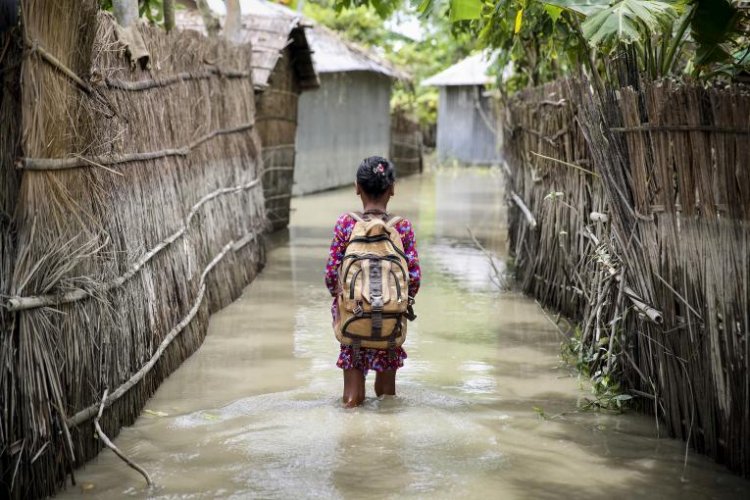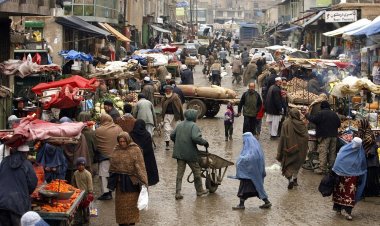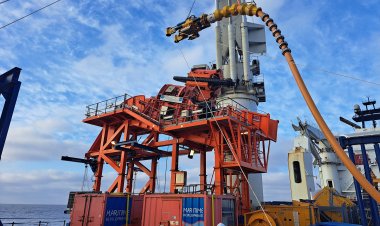Climate refugees from Bangladesh and India's Concerns
There have been different catalysts for triggering cross-border illegal migration into India in different generations. At present, the unprecedented impacts of climate change are crucial in triggering such movement of people – also termed as climate-induced displacement. As the impacts of climate change worsen, the magnitude of cross-border illegal migration into India will rise proportionately, and thus, the necessity of India to shield itself from the spillover effect is gaining momentum as well.

Analysis
By Siddharth Batra
Introduction
The former Prime Minister of India Mr. Atal Bihari Vajpayee once said, "you can change your friends but not your neighbours." Any country needs to maintain decent relations with its neighbouring countries. Apart from maintaining good diplomatic relations, a country must seek to benefit from the prosperity of its neighbour. However, at the same time, it must shield itself from possible negative impacts of any situation developing in its neighbourhood. India and Bangladesh, being neighbours, have built strong diplomatic, economic, and military ties, especially under the leadership of PM Modi. However, one of the impediments in their bilateral relations has been the illegal migration of people from Bangladesh into India. There have been different catalysts for triggering such migration in different generations. At present, the unprecedented impacts of climate change are crucial in triggering such movement of people (also termed as climate-induced displacement). As the impacts of climate change worsen, the magnitude of cross-border illegal migration into India will rise proportionately, and thus, the necessity of India to shield itself from the spillover effect is gaining momentum as well.
Climate Change and Bangladesh
Bangladesh is considered as one of the most vulnerable countries to climate change. The vulnerability of Bangladesh to climate change comes from multiple social, economic, and geographical reasons. First, the country is situated at a low elevation from sea level and has a maritime boundary as well. Therefore, the vulnerability of the country to sea level rise is extremely high. Second, Bangladesh has a high population density (1265 people per sq. km.) Thus, any possible climate change impact will affect a larger population. Third, Bangladesh, being a developing country, lacks the required infrastructure as well as technology to adapt to the possible impacts of climate change. Fourth is the high poverty rate in Bangladesh, which was around 20.5% in 2019, according to Asian Development Bank statistics. The poor are the most vulnerable to the impacts of climate change as they are deprived of alternatives that can minimize adverse effects. Fifth, Bangladesh is already susceptible to extreme events like cyclones, droughts, floods, and cloud bursts. Sixth, 28% of the Bangladesh population lives in the low-lying coastal region and is highly vulnerable to cyclones and possible sea-level rise. Seventh, according to World Bank estimates, 38.3% of the country's workforce is dependent on agriculture and the agriculture sector is threatened by climate-induced soil degradation (which is caused by soil erosion and rising salinity). Lastly, Bangladesh is a riverine country and the total number of rivers that flow through the country is around 700 (including tributaries). This makes the country highly vulnerable to river erosion which can be triggered by cloudbursts.
As the country is highly vulnerable to climate change, the future predictions on the negative impacts of climate change on Bangladesh are immense. A 50 cm sea-level rise is predicted by 2050, which will lead to an 11% loss of Bangladesh's land, especially low-lying coastal region, which is home to 15 million people, and with a 65 cm rise in sea level (by 2080), 40% of the productive land is expected to be lost in South Bangladesh. Also, the country's total area vulnerable to floods will rise by 29% at a 2.5° C rise in temperature. The rise in sea level will also lead to the salinization of coastal freshwater sources, on which 33 million Bangladeshis are dependent. It is also predicted that by 2050, 18 million Bangladeshis will be displaced due to tidal flooding triggered by sea-level rise.
To escape from the impacts of climate change, the vulnerable section of the population of Bangladesh will migrate to other regions, within as well as outside Bangladesh. In fact, they have already begun doing so. Thus, climate change is triggering internal as well as external migration in Bangladesh. At present, 50% of the population in urban slums in Bangladesh are climate-displaced migrants. As far as external migration is concerned, climate change has acted as a catalyst for illegal migration to Bangladesh's neighbours India and Myanmar.
External Migration into India
India has been preferred over Myanmar for illegal migration due to various reasons. First, India being a democratic country has a more politically stable environment. The second reason is the economy. India is the fifth-largest economy in the world by nominal GDP and thus, provides more economic opportunities. Third, West Bengal and the seven North-Eastern states of India already have a settled community of illegally migrated Bangladeshis. Fourth, a major section of the illegal migrants has engaged with the primary sector and the North-Eastern states of India have agriculture as the main occupation. Fifth, the principle of non-refoulment, which forms a part of article 21 of the constitution of India (as declared by Manipur High Court in 2021), allows refugees from other countries the right to freedom from expulsion or forcible return to their home country. This, along with the lack of implementation of the Citizenship Amendment Act, prevents the Indian government from sending illegal migrants back to Bangladesh. Because of the above reasons, there has been a rise in the illegal migration of Bangladeshis into India. In 2017, there were 871 cases of illegal migration into India, which rose to 1118 in 2018 and 1351 in 2019.
The porous border these countries share makes it possible to migrate illegally into India from Bangladesh. The border is porous because it has neither been drawn on the basis of geography nor on the basis of culture. Moreover, it is not easy to keep a vigil on a 4096 km. long border; there is a lack of coordination among the security forces of India and Bangladesh to keep a check on illegal migration.
Challenges for India due to this illegal migration
Challenges arising out of this illegal migration for India spread across five domains. As far as the economic domain is concerned, illegal migrants will utilize not only the land or other natural resources but also job opportunities that Indian nationals could have otherwise utilized. Thus, illegal migration into India will possibly result in the deprivation of resources for Indian citizens. Not only in the economic domain, but climate-induced illegal migration has repercussions in the cultural domain as well. An increase in settlements of Bangladeshi migrants in the Northeastern States, where different tribal regions have unique cultures of their own, will lead to cultural modification. Illegal migration also presents a challenge in the domain of bilateral relations which was witnessed when the Citizenship Amendment Act was introduced in parliament. Bangladesh announced that the Act and the protests related to it were an internal matter of India. However, the Bangladesh government showed resistance in conducting talks with India regarding the same.
Forceful extradition of Bangladeshi illegal migrants by India can very likely create a major impediment in bilateral relations. Among all the domains of challenges, the most concerning is the security aspect of the consequences of illegal migration. Pakistan considers the porous border between India and Bangladesh as an opportunity to infiltrate active terrorists as well as sleeper cells inside India. Porous borders also provide opportunities for radicalized Rohingyas to infiltrate India from Bangladesh. It is to be noted that Rohingyas who have already infiltrated into India have settled in various parts of India, including Jammu & Kashmir and Hyderabad. Bangladesh is also home to multiple terror groups, including the recently revitalized Jamaat-ul-Mujahideen (JBM), which presents a major security threat to India.
How can India deal with the issue of illegal migration from Bangladesh?
To deal with illegal migration and the issues which arise from it, India needs to take effective actions on two fronts. The first is to stop (or contain) further illegal migration. This can be done through various measures like fencing of the border, assisting Bangladesh in achieving climate resilience in the most vulnerable regions through climate adaptation projects. Having bilateral security arrangements with Bangladesh wherein forces of both countries can coordinate their actions to contain illegal migration.
The second front is to deal with illegal migrants who have already entered India effectively. Here, India first needs to identify illegal immigrants. The National Register of Citizens (NRC) can assist the government with this task. Secondly, the Indian government must identify the radical elements among the illegal immigrants and take necessary measures to contain them. Third, the government must make sure the preservation of the culture of the local population (especially in the North-Eastern states) and Indian nationals are given priority as far as utilization of resources is concerned. Fourth, India must utilize its healthy diplomatic relations to persuade the Bangladeshi government to provide economic and social incentives to the illegal immigrants who have migrated to India. Such incentives can lead to reverse migration of the illegal immigrant. Lastly, illegal immigrants can act as a human resource that India can utilize in its economic growth. To transform the human capital of illegal immigrants into a human resource, the government must design and implement relevant education/health/skill development schemes targeted at illegal migrants. The Bangladesh government and relevant UN agencies can be persuaded to fund these schemes.
Conclusion
Illegal immigration from Bangladesh into India has been prevalent for decades due to various reasons (wars, religious persecution, lack of economic opportunities etc). At present, illegal immigration has been triggered by climate change and according to IPCC, the impacts of climate change are going to get worsen in the future. Thus, there is a high possibility of a rise in the number of illegal migrants into India. Therefore, the Indian government must work on this issue on a priority basis and resolve it before the resultant challenges grow beyond the capacity of the government to handle them.
Disclaimer: This article is author’s individual scholastic contribution and does not necessarily reflect the organization’s viewpoint.























